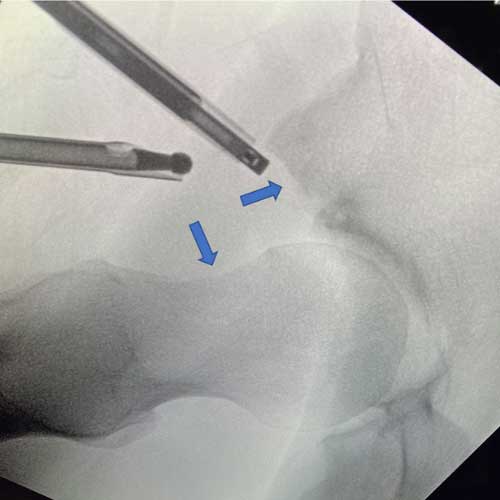Subspine Decompression Surgeon

Are you experiencing hip pain, inflammation and limited function or range of motion of the hip? Subspine impingement, or SSI can occur with or without the presence of FAI and is caused by the abnormal contact between the proximal femur (the upper leg bone) and the AIIS. Doctor Benedict Nwachukwu provides diagnosis as well as surgical and nonsurgical treatment options for patients in Manhattan, New York City, NY who have been diagnosed with subspine impingement. Contact Dr. Nwachukwu’ s team today!
What is subspine impingement (SSI)?
Subspine impingement (SSI) in the hip – also called anterior-inferior iliac spine (AIIS) impingement is an impingement syndrome, similar to femoroacetabular impingement (FAI) that occurs in the hip. Subspine impingement causes hip pain, inflammation and limited function or range of motion of the hip. SSI can occur with or without the presence of FAI and is caused by the abnormal contact between the proximal femur (the upper leg bone) and the AIIS. The AIIS is a bony eminence on the outside border of the hip bone, or on the wing of the ilium (the upper part of the pelvis.)
There are different types of subspine impingement and are classified, based on the location and shape of bony growth or process:
- Type 1: A normal ilium surface that does not have a bony process or growth between the subspine and the rim of the socket. Type 1 does not cause active hip impingement.
- Type 2: A bony process or growth is present and is found on lower end of the subspine, toward the rim of the socket. Type 2 can cause hip impingement and pain.
- Type 3: A bony process, or bone spur, extending downward below the rim of the hip socket. Type 3 subspine impingement can cause the greatest amount of restriction in hip flexion and internal hip rotation
What is subspine decompression?
Dr. Benedict Nwachukwu, orthopedic hip surgeon serving patients in Manhattan, New York City and surrounding New York boroughs has extensive training and experience in treating subspine impingement. Subspine decompression is the treatment he uses to restore the range of motion of the hip, while decreasing inflammation and hip pain. Subspine decompression is done arthroscopically, using a small camera (called an arthroscope) and specialized instruments, used to operate within the hip joint. Dr. Nwachukwu may use a combination of the following procedures to perform subspine decompression:
- Shaving: A specialized tool used to smooth the surface of the bone which is showing a bony protrusion.
- Debridement: Removes loose bodies, such as bone fragments, from the hip joint.
- Avulsion fracture removal: Some cases of subspine impingement can be severe enough that a piece of bone from the subspine area becomes detached, along with the muscle and tendon. The fragment of bone will be removed.
- Femoroplasty: A treatment done, primarily for femoroacetabular impingement (FAI) which may involve a combination CAM deformity and pincer hip impingement. The hip joint is trimmed or smoothed to create a smooth surface and allow the hip a full range of motion.
In the following images Dr. Nwachukwu treats a prominent subspine as well as a CAM deformity:

Pre-Operative Subspine Impingement (SSI)

Post-Operative Shaved SSI/AIIS and Cam Deformity
What are the benefits of subspine decompression?
The primary goal and benefit of subspine decompression is to eliminate hip pain and to restore full range of motion. When subspine decompression is done in conjunction with other hip impingement treatments, it offers the following benefits:
- Helps patients avoid revision hip arthroscopy by 46%
- Allows Dr. Nwachukwu to assess and repair soft tissue abnormalities
- Addresses other forms of hip impingement during the same surgical procedure such as FAI, cam deformity and pincer impingement.
What are the benefits of a postless hip arthroscopy for subspine decompression?
Dr. Nwachukwu is one of the few expert hip surgeons who use a post-less hip arthroscopy technique for all of the hip arthroscopy he performs. You may learn more about postless hip arthroscopy and the many benefits of this specialized approach here: Postless Hip Arthroscopy.
How long is the recovery after subspine decompression?
Recovery times for patients will vary greatly and is affected by the severity of hip impingement, procedures performed and the overall general health of the patient. Typically, a patient can expect the following after subspine decompression:
- A focused, individualized rehabilitation program which begins immediately after surgery.
- Patients are typically on crutches for 3-4 weeks, depending on the procedure(s) performed.
- A brace may be placed, immediately following surgery to protect the hip during healing.
- Substantial improvement in hip range of motion and less pain.
- A return to regular work and sporting activities in 6-9 months.
For more information regarding subspine decompression, hip impingement and other causes of hip pain, or to discuss treatment options available, please contact the office of Benedict Nwachukwu, MD, orthopedic hip surgeon serving Manhattan, New York City and surrounding New York boroughs.